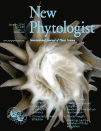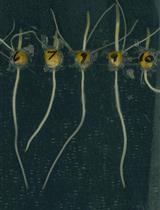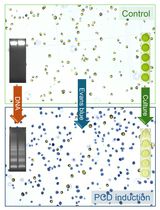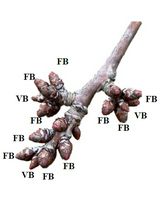- EN - English
- CN - 中文
Forest GPP Calculation Using Sap Flow and Water Use Efficiency Measurements
利用液流和水分利用效率测算森林的GPP
发布: 2017年04月20日第7卷第8期 DOI: 10.21769/BioProtoc.2221 浏览次数: 8744
评审: Arsalan DaudiMarisa RosaSamik BhattacharyaAnonymous reviewer(s)
Abstract
This is a protocol to evaluate gross primary productivity (GPP) of a forest stand based on the measurements of tree’s sap flow (SF), 13C derived water use efficiency (WUE), and meteorological (met) data. GPP was calculated from WUE and stomatal conductance (gs), the later obtained from SF up-scaled from sampled trees to stand level on a daily time-scale and met data. WUE is obtained from 13C measurements in dated tree-ring wood and/or foliage samples. This protocol is based on the recently published study of Klein et al., 2016.
Keywords: Trees (树木)Background
Forests play a major role in the terrestrial carbon cycle through CO2 assimilation and respiration, as well as on the Earth climate by influencing atmosphere CO2 concentration (Luyssaert et al., 2007; Bonan, 2008; Canadell and Raupach, 2008; Reichstein et al., 2013). Gross primary productivity (GPP), plants’ carbon uptake through photosynthesis, is the ultimate source of organic material in land biosphere in general and in food production in particular.
GPP at the ecosystem scale is mainly derived using the eddy covariance (EC) technique, as the difference between EC-measured net ecosystem CO2 exchange (NEE) and the daily inferred ecosystem respiration (Re). The latter one is obtained by extrapolating measured night-time NEE, which equals to ecosystem respiration, Re, to daytime based on empirical equations of Re response to temperature and soil humidity (Aubinet et al., 2000; Baldocchi, 2003; Reichstein et al., 2005; Grunzweig et al., 2009). However, the EC approach has several limitations and uncertainties. Its application is limited to relatively large homogeneous and flat terrains. EC technique is critically dependent on factors such as the system deployment in field (e.g., height above the canopy), on atmospheric conditions (e.g., turbulence conditions, advections) (Aubinet et al., 2000), on corrections applied to data processing programs and algorithms. A common way to assess EC measurements reliability is through the evaluation of the ‘energy closure’ over the measured ecosystem. This test indicates in most sites an energy gap of 20% or more (Foken, 2008). Empirical extrapolation of the night-time NEE measurement to approximate daytime Re has by itself significant uncertainties (e.g., Van Gorsel et al., 2009). NEE measurements provide a whole ecosystem flux only, thus explicit carbon uptake by trees cannot be distinguished from others ecosystem layers. EC measurements are also relatively expensive.
The current protocol describes an alternative method for calculation of forest trees GPP based on measurements of air temperature and humidity, trees’ sap flow (SF) rate and intrinsic water use efficiency (WUEi, the ratio A/gs), where A is the rate of photosynthetic CO2 assimilation and gs is stomatal conductance. This protocol is based on the recently published study of Klein et al., 2016. WUEi is a parameter characterizing plant species, with a seasonal variation (Seibt et al., 2008; Klein et al., 2013 and 2016). It can be calculated from the carbon isotope ratio (δ13C) in the assimilated carbon of plant tissues (Farquhar and Richards, 1984). This is combined with sap flow measurements, which can be obtained easier and at a lower cost than EC measurements, and often have less spatial limitations (independent on ecosystem footprint, topography, homogeneity, etc.), and enable GPP estimation in complex ecosystems. The method is applicable to calculate GPP of woody vegetation and can be considered as total ecosystem GPP if the contribution of understory layer to the total ecosystem GPP can be neglected (e.g., dry environments) or independently assessed. Note that using this approach can also be applied to archived SF and 13C data to reconstruct past variations in GPP, as long as these data are available.
Materials and Reagents
- Forest or woody stand, which can be assumed to be homogenous to facilitate scaling up to stand level
Note: If stand is composed of considerably different plots and species, the method can be applied separately for each plot. The measurements are conducted on living trees. No reagents are used in this procedure.
Equipment
- Tape measure of 2-3 m or caliper for tree diameter at breast height (approximately at 1.3 m, DBH, cm) distribution measurements
- A total station theodolite or at least 30-50 m long tape-measure and compass for establishing a sample plot(s) with known area in order to get stand density
- Sap flow sensors of any suitable type (e.g., EMS Brno, model: THB sensors ; or ICT International, model: HFD8-100 ; or UP, model: TDP sensors , etc.)
Note: The type of sensors depends on tree diameter, financial possibilities, power supply options etc. The most simple, TDP sensors can be manufactured in the institute workshop (see description, e.g., in Lu et al., 2004). - Dendrometers of any type for obtaining of seasonal DBH growth curve (e.g., EMS Brno, model: DRL26C or Natkon, model: Point Dendrometers [Oetwil am See, Switzerland])
- Thermometer and air moisture meter or automatic meteorological station for continuous data recording
- Datalogger for storing sap flow and met’ data (if no own logger is provided by SF and met’ sensors suppliers), e.g., (Campbell Scientific, model: CR1000 ). Most of factory-made sap flow sensors are supplied with own loggers (e.g., EMS Brno, Czech Republic)
- Incremental borer. Short, 5.15’’ borers would usually fit for obtaining wood formed in the recent decade or period of interest
- Equipment for tree rings analysis
Note: Best would be professional dendrometry desk station. Microtome can also help for intra-annual slicing. But the wider the tree-rings are, the easier it is to slice them with scalpel alone. - Laboratory for δ13C analysis
Note: This can be done in house isotope ratio mass spectrometry, or by commercial IRMS service labs.
Procedure
文章信息
版权信息
© 2017 The Authors; exclusive licensee Bio-protocol LLC.
如何引用
Tatarinov, F., Rotenberg, E., Yakir, D. and Klein, T. (2017). Forest GPP Calculation Using Sap Flow and Water Use Efficiency Measurements. Bio-protocol 7(8): e2221. DOI: 10.21769/BioProtoc.2221.
分类
植物科学 > 植物生理学 > 非生物胁迫
植物科学 > 植物生理学 > 植物生长
您对这篇实验方法有问题吗?
在此处发布您的问题,我们将邀请本文作者来回答。同时,我们会将您的问题发布到Bio-protocol Exchange,以便寻求社区成员的帮助。
提问指南
+ 问题描述
写下详细的问题描述,包括所有有助于他人回答您问题的信息(例如实验过程、条件和相关图像等)。
Share
Bluesky
X
Copy link












